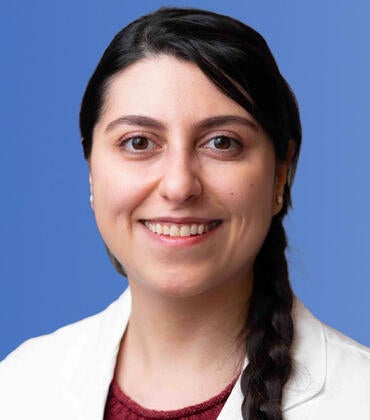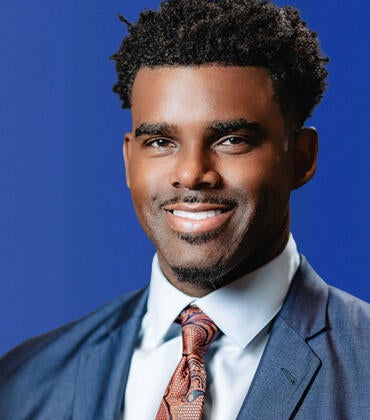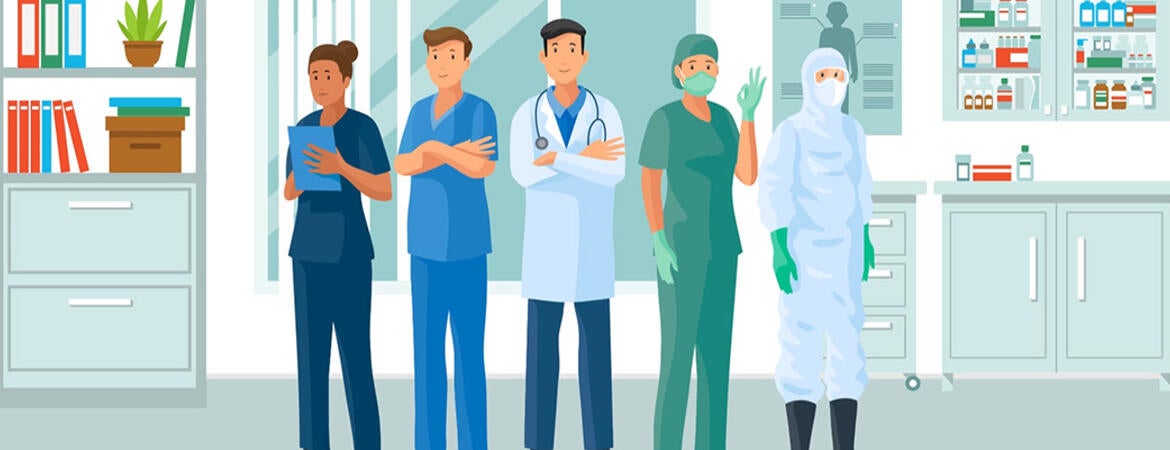
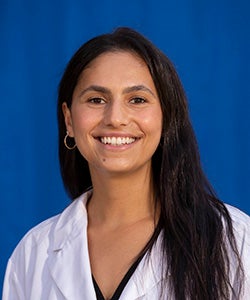
In September 2020, just four weeks after starting her medical education at the UC Riverside School of Medicine and in the midst of a global pandemic, medical student Shamieh Banihani found herself working side by side with Ghassan Hadi, MD, at his private practice in Upland. As Hadi saw patients in person and online, Banihani was right there with him, gaining crucial practical experience through the school’s signature program, the Longitudinal Ambulatory Care Experience (LACE).
Whereas most medical schools keep students solely in the classroom for their first two years of medical education, the LACE program places all of the UCR SOM students with preceptors (local primary care physicians in the community) within weeks of starting their training.
“LACE allows us to actively participate in service of our community right from the get-go, and it allows us to do so in a really safe space,” said Banihani, now a third-year medical student and recent winner of the Outstanding LACE Student MS3 award for 2022-2023. “We can get to know our population in a more vulnerable setting. And to be able to practice medicine as first year students, that's pretty awesome and unique.”
What is LACE?
LACE works like this.
Medical students are assigned to preceptors who volunteer to serve as mentors and oversee students as they work directly with their patients. First- and second-year students visit their LACE site every other week for half a day, increasing to every week during their third year of medical school.
“The program bridges the gap between learning and clinical application by providing our students hands-on experience with community-based primary care providers throughout the Inland Empire,” explained Patricia Walker, associate director of LACE.
“LACE introduces our students to diverse populations that reflect our healthcare delivery systems right now, today,” added Walker. “The program also creates sustained mentee-mentor relationships between our students and healthcare providers in our region and maintains the growth of healthcare in the Inland Empire.”
She said a common misconception is that the program immediately allows students to work toward their potential future specialties by matching them to their interests. This isn’t the case, as students can’t choose their LACE site, but Walker said it doesn’t matter. No matter where students end up in the area for their LACE training, they are each paired with carefully selected and dedicated physician preceptors who help them learn valuable lessons about the local community and their place in it as doctors. Whether a student is an aspiring family physician or future anesthesiologist, they benefit from real-world examples of compassionate and effective doctoring.

“It really helps students identify if they really want to do this,” said Walker. “They get to see candid moments.” She recalled a student who, after working with a private practitioner as her LACE preceptor, realized she wanted to work for a healthcare organization rather than running her own private practice. Through LACE, students can immediately see the challenges that are part of healthcare, whether it’s working with patients or handling bureaucracy, insurance, or policies so they’re not surprised later on.
Since students start working with patients at the very beginning of their medical education and follow up with them throughout their time in school, the work complements their classroom studies while giving them a head start on their skills. “Students integrate their lessons in anatomy, physiology, and pharmacology as they work directly with patients,” said Walker. “And then they also develop skills and knowledge related to patient history, like performing a physical exam, presentation, and doctor-patient interaction and communication to improve their clinical competencies as well.”
Benefiting students and local physicians
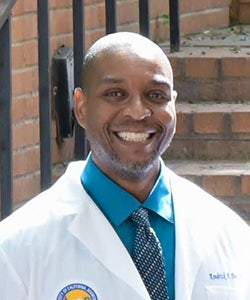
The extra years of preparation give UCR SOM students an experiential advantage over their peers in other schools. “Our clinical partners and mentors have repeatedly expressed how much more advanced our students are versus medical students who are in more traditional schools that begin clinical rotations during the third year of medical school,” said Kendrick Davis, PhD, a health sciences associate clinical professor, co-founder, and previously the co-director of LACE. “Our medical students are also far more prepared to complete quality improvement research projects, to incorporate evidence-based practices into their clinical work, and to become clinical researchers.”
Davis said that LACE has provided many of the benefits that he envisioned with his co-founders Michael Nduati, MD, an associate clinical professor of health sciences, and Paul Lyons, MD, the former senior associate dean for education.
“I would argue that LACE is the most mission-centric program we have,” said Davis. “LACE enables our medical students to both interact with the diverse patient population we service for longer and more meaningful periods of time, and to also establish what students call a ‘clinical home’ that truly aids in their clinical development through outstanding team-based clinical mentorship, support, and hands-on experiences.”
The program doesn’t just benefit students. The sustained mentor relationships it creates are rewarding for local doctors, too.
When Walker recently received a call from a LACE preceptor, she at first felt nervous, wondering if there was an issue with the student. Instead, she recalled that the doctor gave glowing remarks, sharing an example of the student overcoming nerves to take a patient’s blood pressure. “The doctor stated it may have taken 10 minutes to take the blood pressure, but it didn't matter because he wanted to ensure that the student learned from the experience,” Walker later wrote from her notes on the conversation. “He understood that the student was new at the site, and he's there to learn, and the patients were very accepting of him.” The doctor finished by saying that, after 38 years of practice, he still enjoyed teaching and learning from students and was grateful to have the opportunity to teach future physicians.
Building a foundation for new physicians

After the call, Walker shared the story with Moazzum Bajwa, MD, an assistant clinical professor of health sciences and co-director of the LACE program alongside E. Caroline McGowan, MD, a pediatrician at UCR Health.
A LACE preceptor himself, Bajwa understood the experience the doctor had described. “Obviously there's a benefit to the student with LACE, but there's a huge benefit to the preceptors as well, reconnecting with the things that brought you into medicine in the first place,” he said.
He explained that he particularly loves working with first- and second-year medical students as a preceptor. “It's a different perspective when you're working with students really at that formative part of their development,” he said.
When Bajwa became director of the program in 2020, he focused on using LACE to give students a foundation to develop as physicians despite the disruptions of the COVID-19 pandemic.
This was something he had personally struggled during his first few years of medical school. “I felt very strongly that students need an inclusive space to develop their identities in a positive way, and also to practice their skills with an expert clinician,” Bajwa said.
He referenced a phenomenon known as the “hidden curriculum,” in which subconscious behaviors and messages from peers and supervisors influence students’ values and identities, sometimes causing distress particularly in their later years of medical school. “We have a lot of good evidence that if we allow students and even physicians the opportunity to reflect on some of those factors, and think about the ways that they may be influencing their values and identities, then we can actually help them modulate the impact and decrease the negative aspects and promote the positive ones,” he explained. “To me, that's really one of the key components of the LACE program.”
“LACE is sort of a medical school within a medical school,” Bajwa added. “As happens with medical school, oftentimes students get lost in the minutiae of studying pharmacology and microbiology, and lose sight of that bigger picture of what drew them into medicine in the first place, which is that physician-patient interaction. And so the clerkship allows them to renew that enthusiasm by, every two weeks, going to work directly with patients in the community under supervision of a primary care physician, and practice their clinical reasoning skills and discover what it means to be a physician.”
For Bajwa, it comes down to not only being accountable to patients in the community, but to the medical students themselves. “They've put a lot of time and effort into becoming medical students, becoming future physicians, and I want them to know that in LACE we are trying to meet that mission by allowing them to become the type of people that they sought out to be as they wrote their personal statements,” said Bajwa. “I think a lot of schools are figuring out ways to do this, but I haven't seen one where they integrate both the clerkship and the curriculum across those three years in a dedicated, meaningful way, with a particular focus on professional identity formation and clinical reasoning.”
The program is also unique in that it offers students continuity of care, working with the same patients across months or years and observing how the social determinants of health they learn about in the classroom truly affect patients’ lives. “When I get to see the students piece those together, it's really a beautiful thing,” said Bajwa.
He added that preceptors also note the difference. Compared to students at other schools, “UCR students are able to see the whole picture of the entire patient as a person in a community, as opposed to just one patient with one disease as one case on one day,” said Bajwa. “For me, that's my vision of medicine and public health.”
A safe space
All medical students interact with patients as part of their education, but LACE is also unique in that it provides students with a safe space to learn.
Bajwa explained that in clerkships at traditional medical schools, students’ performance is tied to their grade, which in turn can affect their chance of being accepted into a residency program. “If a student feels like everything they do in a clerkship is going to impact their grade, they do not have psychological safety to perform, and mess up and do better and try again,” Bajwa said. “So we explicitly don't make that a part of their grade.”
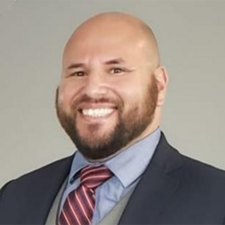
This is exactly what Daniel Novak, PhD, a health sciences assistant clinical professor and director of scholarly activities and another leader in LACE, is going for. “This sounds a little cynical, but pretty much every other part of medical education tries to beat any sort of creativity out of the students,” said Novak, whose role involves supporting students’ research projects and helping integrate LACE with the medical school curriculum. “In LACE, because you're not in such a high-risk situation, you get a little bit of opportunity to try different things, to fail constructively, and to try out in a realistic context actual skills you're developing.”
Students appear to appreciate this, especially once they start their third-year rotations. “When you actually go to the hospital and do your rotations, you feel more pressure to always know the right answers or the right physical exams because it is a more structured environment and you're worried about how you're going to be graded,” said Banihani. But in LACE, “you're there just to learn, which is so freeing, and you don't learn to appreciate how freeing that is until you see the other side,” she continued. “There's no other safe space like it.”
A community-based medical school
Organizing the program, especially with independent physicians across the community, requires a coordinated effort.
“It's certainly not easy to find 200 community physicians in a medically underserved area, but Patty and our team work really hard not just to identify excellent partners, but to maintain strong relationships with them over time,” said Bajwa.
Because the first two years already have so many requirements filling students’ schedules, Bajwa noted that the medical school must strongly support the program to make everything work. “UCR absolutely does; we get dedicated time, required lectures, and protected time to focus on all of this LACE work, which is really nice,” said Bajwa, adding that support from Deborah Deas, MD, the vice chancellor for health sciences and the Mark and Pam Rubin dean of the School of Medicine, and Pablo Joo, MD, senior associate dean for medical education have been essential for growing the program. “The school is putting an emphasis on this in a real way and recognizing that this is a critical part of their students' foundation.”
Overall, “The purpose of the clerkship is really to give our students the skills and space to find out what it means to be a physician who treats themselves and their patients with dignity and respect,” Bajwa said, explaining that the program starts students’ professional identity formation as they develop into physicians, advocates, and ultimately, leaders in the community. “LACE is everything that I wish that I had learned when I was in medical school.”
Creating future community physicians
Based on students’ and preceptors’ feedback, LACE is working as intended: creating future physicians who understand social determinants of health and have strong ties to the local community.
“We're doing amazing things, but because we're so focused on benchmarks or LCME accreditation, and this, that and the other, I don't know if we've all collectively taken stock of just the tremendous growth that we've had,” said Bajwa. “I think we get so caught in the weeds that we don't often stop and look back.”
Recognizing the program’s past growth is important, but so is looking forward.
“When you spend your first two years of medical school studying for your board exams, you can forget what clinical medicine really looks like and the goal we’re all working towards of serving our community, and being in LACE clinics reminds you,” said Banihani. “LACE has a special way of making us feel like we have our own patients and people who really depend on us,” she added. “I think LACE has reinforced who I want to serve and who I want to work for one day.”
